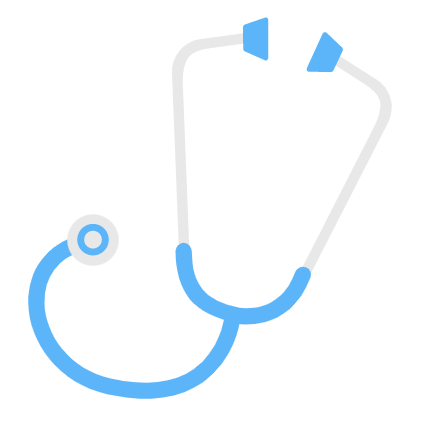ABDOMINAL EXAM
Introduction
- Knock, enter the room, wash/sanitize hands and Introduce yourself as a medical student
- Greet the patient, ask the patient’s name, explain the exam and ask for consent
- Always take vitals before physical exam
- Advise and request patient to drape properly (mention what type of exposure is necessary)
Inspection
Patient can sit on the examination table for the inspection exam
| General | Inspect for increased work of breathing, body habitus |
| Face | Inspect for stigmata of liver disease (parotid enlargement, frontal balding, temporal muscle wasting, fetor hepaticus) Ask patient to pull down lower eyelids to inspect for scleral icterus or jaundice |
| Hands | Look for tere’s nails, palmar erythema, thenar atrophy, hypothenar atrophy, leukonychia Look for Asterixis and Dupuytren’s Contracture |
| Abdomen | Inspect the abdomen and report the shape of the abdomen, also noting bulging flanks, hernias or surgical scars Look for stigmata of liver disease such as spider angiomas, caput medusae, ascites, gynecomastia/hypogonadism (if male) |
| Cullen’s Sign | Inspect for bruising around the umbilicus |
| Grey-Turner Sign | Inspect for bruising in the flanks of the abdomen |
Auscultation
- Bowel Sounds (Diaphragm of Stethoscope)
- Auscultate for normal bowel sounds over the 4 quadrants
- If you hear bowel sounds in one region, stop this maneuver, and report that bowel sounds were heard in the respective quadrant within 2 minutes
- Absent bowel sounds can indicate obstruction or ileus
- Abdominal Bruits (With bell of stethoscope)
- Auscultate for bruits in the renal, iliac, and femoral arteries.
- Renal
- 5cm superior and lateral of the umbilicus
- Iliac
- 5cm inferior and lateral of the umbilicus
- Abdominal Aorta
- Just superior to the umbilicus
- Femoral
- Halfway between the ASIS and pubic symphysis
- Bruits will sound like a “whoosh”. Clarify if the bruit is systolic or systolic-diastolic (using carotid upstroke) and which side it lateralizes to
- Venous Hum (with bell of stethoscope)
- Listen for a hum over the epigastric and umbilicus areas. Note that no hum was heard over these areas
- Friction Rub (with diaphragm of stethoscope)
- Listen for a rough and high-pitched rub over the spleen and liver. Note that there is no friction rub heard in the lower right or left costal areas
- Liver Scratch Test
- Only done in patients with obesity (special test)
- See below for a full description of maneuver
- Hepatic Congestion
Percussion
- Transition statement and explanation of percussion
- Percuss all 9 abdominal regions and note sounds head (tympanic, dull)
- Percuss for liver span
- Begin at the right ASIS at MCL and percuss up with each inspiratory rise
- Not progression from tympanic → dull → resonant and note the liver span (normal 6-12cm)
- Castell’s Sign
- Percuss area defined by the last intercostal space along the anterior axillary line during inspiration, looking for shift to dullness
- Percuss throughout respiratory cycle
- Castell’s sign yields resonant sounds throughout
- Percuss area defined by the last intercostal space along the anterior axillary line during inspiration, looking for shift to dullness
- Traube’s Space
- Percuss the area defined by the sixth rib superiorly, the anterior axillary line laterally, and the left costal margin inferiorly
- Can percuss along a straight line following the left last intercostal space anteriorly until reaching anterior axillary line
- Traube’s space yields resonant sounds throughout
- Percuss the area defined by the sixth rib superiorly, the anterior axillary line laterally, and the left costal margin inferiorly
- Conditional Tests to perform for Ascite
- See special tests section for more information
- Fluid Wave Test
- Shifting Dullness Test
Palpation
- Light and Deep Palpation
- First, lightly palpate in all 9 regions of the abdomen and assess for pain in all 9 quadrants.
- Simultaneously assess for rigidity. If a patient has pain, deep palpation is not recommended in that quadrant.
- Next, deeply palpate (abdomen should visibly depress) in all 9 regions.
- Assess for rigidity and pain.
- First, lightly palpate in all 9 regions of the abdomen and assess for pain in all 9 quadrants.
- Rebound Tenderness
- Only assess in areas of tenderness identified on palpation.
- In those areas, press down and hold, then release. Look for the patient’s face for signs of pain, especially on release.
- May be a sign of peritonitis
- Palpation of liver edge
- Stand on the right side of the bed and make an L with your hand to mimic the edge of the liver.
- Start in the RLQ at the ASIS.
- Move up 2cm from this point with each rise of the patient’s belly (consistent with liver moving down with inspiration)
- The liver should only be palpable less than 2cm below the right costal margin along the MCL
- If the liver is palpable on rest inspiration >2cm, likely hepatomegaly.
- Check for
- Consistency (nodules indicate cirrhosis)
- Tenderness (inflammation)
- Pulsatility (Tricuspid Regurg specific finding)
- Check for
- Alternatively
- Hook under the right MCL below the costal margin and ask the patient to inspire deeply, might feel the liver as it moves down.
- Splenic Palpation
- Use deep palpation beginning in the RLQ along the MCL and move diagonally towards the LUQ
- Note the spleen is non palpable from RLQ to LUQ
- DRE
- ALWAYS offer to do a DRE exam in an OSCE, but never asked to perform for an OSCE
- If indicated/suspected
- Appendicitis Tests
- McBurney’s Point
- Rovsing’s Sign
- Psoas’ Sign
- Obturator Sign
- Cholecystitis Tests
- Murphy’s Sign
- Appendicitis Tests
